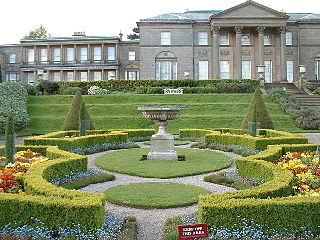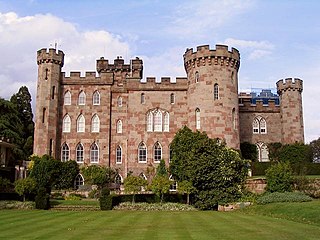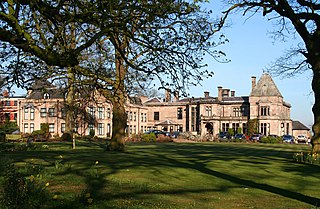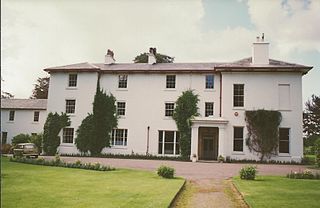Mere New Hall stood to the east of the village of Mere and the junction of the A566 and A50 roads in Cheshire, England. It was largely destroyed by fire in 1975.
It was built in 1834 for Peter Langford Brooke to replace Mere Old Hall, the architect being Thomas Johnson of Lichfield. It was a large symmetrical house in Elizabethan style, constructed in brick and decorated with diapering. Its features included a porte-cochère, turrets, and shaped gables. However the house proved to be too large for the family and they returned to the Old Hall in 1914, letting the New Hall initially to George Smith Ollerenshaw and his wife Hannah who opened it to Belgian officers wounded in World War One. Eventually it was sold and became a country club in 1938. In 1975 most of the building was destroyed by fire, although a fragment of it remains, together with a modern extension. [1] As of 2011 it is a golf resort and a spa. [2]
Two structures associated with the house are recorded in the National Heritage List for England as designated Grade II listed buildings. These are the stable block, [3] and the entrance arch and gates. [4]

Lyme Park is a large estate located south of Disley, Cheshire. The estate is managed by the National Trust and consists of a mansion house surrounded by formal gardens, in a deer park in the Peak District National Park. The house is the largest in Cheshire, and is recorded in the National Heritage List for England as a designated Grade I listed building.

Tabley House is an English country house in Tabley Inferior, some 3 kilometres (1.9 mi) to the west of the town of Knutsford, Cheshire. The house is recorded in the National Heritage List for England as a designated Grade I listed building. It was built between 1761 and 1769 for Sir Peter Byrne Leicester, to replace the nearby Tabley Old Hall, and was designed by John Carr.

Hinderton Hall is a country house to the northeast of Neston, Cheshire, England.

Capesthorne Hall is a country house near the village of Siddington, Cheshire, England. The house and its private chapel were built in the early 18th century, replacing an earlier hall and chapel nearby. They were built to Neoclassical designs by William Smith and (probably) his son Francis. Later in the 18th century, the house was extended by the addition of an orangery and a drawing room. In the 1830s the house was remodelled by Edward Blore; the work included the addition of an extension and a frontage in Jacobean style, and joining the central block to the service wings. In about 1837 the orangery was replaced by a large conservatory designed by Joseph Paxton. In 1861 the main part of the house was virtually destroyed by fire. It was rebuilt by Anthony Salvin, who generally followed Blore's designs but made modifications to the front, rebuilt the back of the house in Jacobean style, and altered the interior. There were further alterations later in the 19th century, including remodelling of the Saloon. During the Second World War the hall was used by the Red Cross, but subsequent deterioration prompted a restoration.

Tatton Park is an historic estate in Cheshire, England, north of the town of Knutsford. It contains a mansion, Tatton Hall, a medieval manor house, Tatton Old Hall, Tatton Park Gardens, a farm and a deer park of 2,000 acres (8.1 km2). It is a popular visitor attraction and hosts over a hundred events annually. The estate is owned by the National Trust, who administer it jointly with Cheshire East Council. Since 1999, it has hosted North West England's annual Royal Horticultural Society flower show.

Mere is a civil parish and linear village along the old course of the A556 road in the unitary authority of Cheshire East and the ceremonial county of Cheshire, North West England, about 7 km (4.3 mi) south-west of Altrincham. Bucklow Hill is at its northeast end, and the Mere crossroads is at the southwest end. The village of Mere is about a mile long and has a varied stock of housing. Most houses are large and have ample gardens leading down to the lake; these are along the inner sides of a triangle formed by the A556, A50 and A5034 roads. Inside the triangle is a lake after which Mere was named, and a golf and country club.

In the early 18th century the Oulton Estate was home to the Egerton family and comprised a manor house and a formal garden surrounded by farmland in Cheshire, England. Later in the century the farmland was converted into a park. The estate is now the site of the motor racing track called Oulton Park.

Cholmondeley Castle is a country house in the civil parish of Cholmondeley, Cheshire, England. Together with its adjacent formal gardens, it is surrounded by parkland. The site of the house has been a seat of the Cholmondeley family since the 12th century. The present house replaced a timber-framed hall nearby. It was built at the start of the 19th century for George Cholmondeley, 1st Marquess of Cholmondeley, who designed most of it himself in the form of a crenellated castle. After the death of the Marquess, the house was extended to designs by Robert Smirke to produce the building in its present form. The house is designated by English Heritage as a Grade II* listed building.

Rookery Hall is a Georgian style mansion located off the B5074 road near the village of Worleston in Cheshire, England. Dating originally from 1816 but extensively altered in the late 19th century, the hall is listed at grade II. Since 1999 Rookery Hall has been owned and managed by Julia Hands, Hand Picked Hotel Group. The Conference centre and Health Club and Spa were added in 2011.

Peover Hall Stable Block is in the grounds of Peover Hall, Cheshire, England. It is recorded in the National Heritage List for England as a designated Grade I listed building.

Peover Hall is a country house in the civil parish of Peover Superior, commonly known as Over Peover, Cheshire, England. It is recorded in the National Heritage List for England as a designated Grade II* listed building.
Alderley Old Hall is the remaining part of a former 17th-century manor house near the village of Nether Alderley, Cheshire, England. It stands adjacent to the mill pond of Nether Alderley Mill, a loop of which acts as a moat. The hall is recorded in the National Heritage List for England as a designated Grade II* listed building.

Toft Hall is a 17th-century country house in Toft, Cheshire, England to which additions and alterations have been made during the following three centuries.

Ashley Hall is a country house standing to the north of the village of Ashley, Cheshire, England. It dates from the late 16th to the early 17th century, with additions made in the 18th and 19th centuries. The house is historically important because it was here that the Cheshire gentlemen met in 1715 to decide whether to support the Stuarts or the Hanoverians. They decided on the latter and later commissioned a set of portraits, which now hang in Tatton Hall. The house is recorded in the National Heritage List for England as a designated Grade II listed building. Also listed at Grade II are the gate piers to the forecourt of the building, a carriage house in the forecourt, the kitchen garden wall, and the stable block. For the 2019 biopic Tolkien, 15 acres of the Tatton Estate were used to recreate the trenches of the First World War.

Chorlton Hall is a country house in the parish of Chorlton, Cheshire, England. It stands some 1.5 miles (2.4 km) northwest of Malpas. The house dates from the 17th century, with additions made in the second quarter of the 19th century. Its entrance front is pebbledashed and it stands on a stone plinth. The roof is slated. The house is in 2½ storeys plus cellars. Across the front are three bays, each with a gable, and with the central bay protruding. On the gables are ball finials. The porch has an ogee-arched entrance. The house is recorded in the National Heritage List for England as a designated Grade II listed building. A stable block and two cottages to the southeast of the house have also been designated at Grade II.

Crag Hall is a country house located to the east of the village of Wildboarclough, Cheshire, England. It was built in 1815 by George Palfreyman, the owner of a textile printing works nearby. It has since been extended by the addition of large curved bow windows at each end of the entrance front. The house is constructed in brick-sized blocks of brown sandstone, with ashlar quoins and dressings. It is roofed in slate. The house is in two storeys. The entrance front has five bays. In the centre is a raised portico with four Ionic columns. It is approached from each side by a flight of steps. Its base is rusticated and contains three arched recesses. Above the portico is a window with an entablature. About the house, Figueirdo and Treuherz comment that "it has an imposing air of millstone grit solidity". The house is recorded in the National Heritage List for England as a designated Grade II* listed building. Associated with the house are three structures listed at Grade II. These are the gateway with its wing walls, the retaining wall to the garden terrace, and a wall and summer house in the garden.

Mere Old Hall is a 17th-century country house which stands to the west of the village of Mere and the junction of the A566 and A50 roads in Cheshire, England.

Ramsdell Hall is a country house in the parish of Odd Rode in Cheshire, England, overlooking the Macclesfield Canal. It was built in two phases during the 18th century, and is still in private ownership.
Mere is a civil parish in Cheshire East, England. It contains nine buildings that are recorded in the National Heritage List for England as designated listed buildings, all of which are at Grade II. This grade is the lowest of the three gradings given to listed buildings and is applied to "buildings of national importance and special interest". The parish is almost entirely rural. The listed buildings include Mere Old Hall and associated structures, structures associated with Mere New Hall, cottages, a farmhouse, a hotel, and an AA telephone booth.

Ince Blundell Hall is a former country house near the village of Ince Blundell, in the Metropolitan Borough of Sefton, Merseyside, England. It was built between 1720 and 1750 for Robert Blundell, the lord of the manor, and was designed by Henry Sephton, a local mason-architect. Robert's son, Henry, was a collector of paintings and antiquities, and he built impressive structures in the grounds of the hall in which to house them. In the 19th century the estate passed to the Weld family. Thomas Weld Blundell modernised and expanded the house, and built an adjoining chapel. In the 1960s the house and estate were sold again, and have since been run as a nursing home by the Canonesses of St. Augustine of the Mercy of Jesus.
Coordinates: 53°19′56″N2°24′25″W / 53.33222°N 2.40704°W